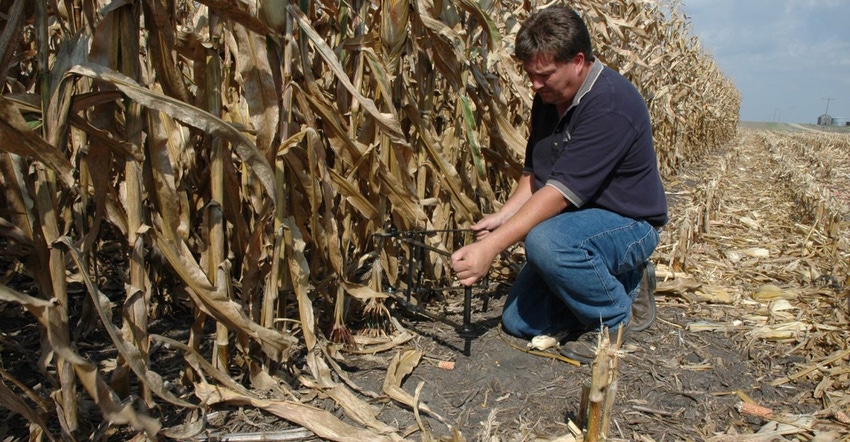September 10, 2019

Sampling cornstalks this fall for the end-of-season stalk nitrate test will likely be later than normal due to delayed planting in many fields last spring. The overall suggestion is to wait until crop maturity, and sample within one to three weeks after corn forms the black layer in the kernels. Black layer formation occurs when the plant reaches maturity.
“However, this doesn’t work well for silage corn,” notes John Sawyer, Iowa State University Extension agronomist specializing in soil fertility and nitrogen management. “So the suggestion for silage corn is to collect stalk samples at the time of silage harvest or within 24 hours after harvest, as long as no rain occurs between harvest and sampling.”
The ISU Extension publication with information on using the end-of-season cornstalk nitrate test was updated in 2018. Use of the End-of-Season Corn Stalk Nitrate Test in Iowa Corn Production, CROP 3154, describes the sampling protocol and interpretation of results.
Categories of interpretation
The old interpretation categories for nitrate content as shown in the test results were adjusted; now there are three new categories:
low (less than 250 parts per million)
sufficient (250 to 2,000 ppm)
high (over 2,000 ppm)
As was recommended in the previous ISU publication, the most reliable interpretation is with high concentrations of nitrate present. A high concentration of nitrate in the stalk at the end of the growing season indicates there was more than enough plant-available nitrogen present in the field for that year.
“Also, as noted in the previous recommendations, don’t base your nitrogen management changes on only one year of results,” Sawyer says. “Instead, sample the stalks at the end of the growing season for multiple years to build a trend database.”
The stalk segment to take as a sample remains the same. Remove an 8-inch segment of stalk from 6 to 14 inches above the ground. Avoid sampling odd plants or plants damaged by disease or insects. Collect 15 stalk segments per sample area. Place stalk samples in paper (not plastic) bags. If needed, refrigerate until taking or shipping samples to the lab for testing.
Test reliability, precautions
The concentration of nitrate-N in the lower cornstalk at the end of the season reflects all factors that influenced N availability and crop N needs during the growing season, Sawyer says. A cornstalk nitrate test result within the sufficient category indicates a high probability that N supply was adequate for the conditions during the growing season.
Because many factors influence N availability, however, mainly after manure and fertilizers are applied, it is unrealistic for stalk nitrate concentrations to be in sufficient in all fields in all years.
Many factors can influence test results, including drought, high rainfall, poor ear development, long end-of-season grain fill, hybrid used, and insect or disease damage. When interpreting test results, consideration must be given to these factors and conditions that occurred during the growing season, especially during grain development, that may affect poor grain production or fill (drought, poor kernel development) or provide for prolonged and exceptional grain fill (high N use by the plant).
“Typical suggested rates of fertilization can result in low or high cornstalk nitrate test concentrations, but are not too low or too high N rates in most years,” he notes.
Zero in on N application rate
Fertilization rates can be increased in future years for fields or areas that usually test in low, and rates decreased for fields or areas that usually test in high, Sawyer says. The test does not directly indicate how much N application rates should be increased or decreased. However, continued use of the test for several years will provide a trend and thus allow adjustments that move concentrations more frequently into the sufficient category.
The stalk test is reliable at indicating situations when too much N was available and can help reduce the chances of over-application of nitrogen.
Many producers associate a dark-green plant throughout the growing season with an optimal rate of N fertilization. “However, corn leaves on the lower part of the plant tend to lose their green color late in the season even when economically optimum nitrogen rates were applied,” Sawyer says. “Thus, the end-of-season cornstalk test can help producers understand if there has been overfertilization that reduces profitability and increases the chance of nitrate loss to water systems.”
Collecting a good sample
When using the end-of-season cornstalk nitrate test, you should:
Sample one to three weeks after black layer.
Collect 15 8-inch stalk segments between 6 and 14 inches above the soil surface.
Randomly select stalks from about a 1-acre area that represents a larger area.
Separately sample different soil types and management areas.
Place stalks in paper bags, not plastic, for shipment to the lab.
Ship samples within one day or refrigerate until shipping.
About the Author(s)
You May Also Like






